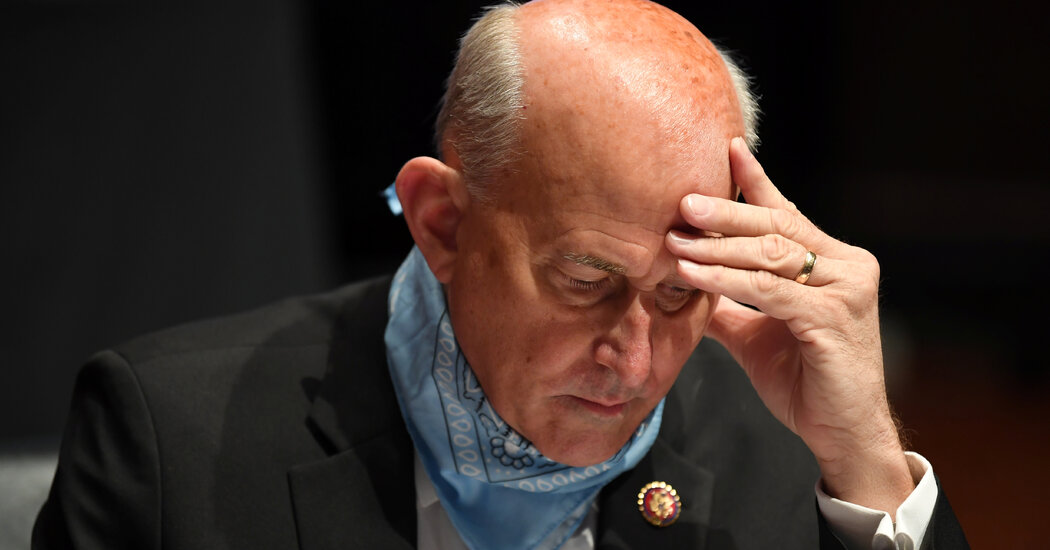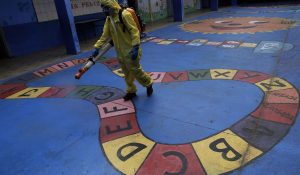Representative Louie Gohmert, a Texas Republican who has frequently refused to don a face covering in the Capitol, confirmed on Wednesday that he had tested positive for the coronavirus before a planned trip with President Trump on Air Force One, and he blamed his diagnosis on wearing a mask.
The results immediately sent a shudder through the Capitol, where this week Mr. Gohmert has been voting and actively participating in congressional hearings, including a Judiciary Committee session on Tuesday with Attorney General William P. Barr and another held by the Natural Resources Committee.
Speaker Nancy Pelosi announced Wednesday a new mandate requiring lawmakers and staff to wear masks on the House floor and in House office buildings, on penalty of removal. And at least three colleagues and several aides who had contact with Mr. Gohmert announced they would quarantine, while Mr. Barr planned to be tested.
Mr. Gohmert, 66, said he was not experiencing symptoms but had notified colleagues with whom he may have come into contact.
Smiling in a video recorded in his Capitol Hill office, he declared he had probably gotten the “Wuhan virus” because he had started wearing a mask over the past week or two — not despite it.
Mr. Gohmert’s use of the term flew in the face of warnings from medical historians and public health experts that associating a pandemic with a particular ethnic group can lead to discrimination. And his theory for how he contracted the virus contradicted the overwhelming consensus of medical experts that wearing a mask is one of the most effective ways to limit the spread of the disease.
His diagnosis also revived urgent questions about whether it was safe for Congress — with its 100 senators and 435 representatives, many of them over 65 and thus at higher risk for the virus — to continue to meet amid the pandemic, and whether lawmakers were taking sufficient precautions. Members have adopted unevenly enforced safety protocols and allowed themselves to bounce each week between the capital and their home states, some of which are experiencing surges of the virus, without getting tested.
House and Senate leaders turned down an offer from the White House in May for rapid-testing ability, saying that they would prefer that resources be sent to front-line workers. On Wednesday, their top deputies said the time had come to reconsider.
“For members of Congress who are going back and forth, they represent sort of the perfect petri dish for how you spread a disease,” said Senator Roy Blunt, Republican of Missouri and the chairman of the Rules Committee. “Send 535 people out to 535 different locations on about 1,000 different airplanes, and bring them back and see what happens. It seems to me there’s a better path forward.”
Representative Steny H. Hoyer, Democrat of Maryland and the majority leader, said he planned to press Ms. Pelosi and the House Republican leader, Kevin McCarthy of California, on the matter. Mr. McCarthy urged his members to wear their masks and renewed previous calls for lawmakers to be tested regularly.
To date, Ms. Pelosi had required masks be used in House hearings and encouraged — but not required — their use on the floor. She said Wednesday that she considered doing so “a sign of respect” and that failing to wear a facial covering on the House floor going forward would be treated as “a serious breach of decorum” that could lead to a member’s removal from the floor.
Mr. Gohmert is far from the first member of Congress to contract the coronavirus. A tally maintained by GovTrack puts that number at 10, with dozens more having isolated for a period of time after coming into contact with someone carrying it. But not since Senator Rand Paul of Kentucky tested positive in late March as senators were trying to cinch a coronavirus relief deal has Congress been so shaken by signs of the virus circulating among its ranks.
By midafternoon, lawmakers, support staff and journalists were racing to isolate themselves after possible exposure, as health officials were left to try to retrace Mr. Gohmert’s steps. It was a daunting task because Mr. Gohmert is a frequent schmoozer who could have come into close contact with dozens of fellow lawmakers and aides this week alone.
Dr. Brian P. Monahan, Congress’s attending physician, advised members of the Judiciary Committee that they could be at elevated risk if they sat near Mr. Gohmert or used the same equipment, but said Democrats, at least, did not need to quarantine.
Representative Raúl M. Grijalva, Democrat of Arizona and the chairman of the Natural Resources Committee, said in a statement that he would isolate himself until he could get test results because of extended contact with Mr. Gohmert in his committee’s hearing.
“In the meantime, my work schedule and the lives of my employees are disrupted,” said Mr. Grijalva, 72. “This stems from a selfish act by Mr. Gohmert, who is just one member of Congress.”
The Coronavirus Outbreak ›
Frequently Asked Questions
Updated July 27, 2020
-
Should I refinance my mortgage?
- It could be a good idea, because mortgage rates have never been lower. Refinancing requests have pushed mortgage applications to some of the highest levels since 2008, so be prepared to get in line. But defaults are also up, so if you’re thinking about buying a home, be aware that some lenders have tightened their standards.
-
What is school going to look like in September?
- It is unlikely that many schools will return to a normal schedule this fall, requiring the grind of online learning, makeshift child care and stunted workdays to continue. California’s two largest public school districts — Los Angeles and San Diego — said on July 13, that instruction will be remote-only in the fall, citing concerns that surging coronavirus infections in their areas pose too dire a risk for students and teachers. Together, the two districts enroll some 825,000 students. They are the largest in the country so far to abandon plans for even a partial physical return to classrooms when they reopen in August. For other districts, the solution won’t be an all-or-nothing approach. Many systems, including the nation’s largest, New York City, are devising hybrid plans that involve spending some days in classrooms and other days online. There’s no national policy on this yet, so check with your municipal school system regularly to see what is happening in your community.
-
Is the coronavirus airborne?
- The coronavirus can stay aloft for hours in tiny droplets in stagnant air, infecting people as they inhale, mounting scientific evidence suggests. This risk is highest in crowded indoor spaces with poor ventilation, and may help explain super-spreading events reported in meatpacking plants, churches and restaurants. It’s unclear how often the virus is spread via these tiny droplets, or aerosols, compared with larger droplets that are expelled when a sick person coughs or sneezes, or transmitted through contact with contaminated surfaces, said Linsey Marr, an aerosol expert at Virginia Tech. Aerosols are released even when a person without symptoms exhales, talks or sings, according to Dr. Marr and more than 200 other experts, who have outlined the evidence in an open letter to the World Health Organization.
-
What are the symptoms of coronavirus?
- Common symptoms include fever, a dry cough, fatigue and difficulty breathing or shortness of breath. Some of these symptoms overlap with those of the flu, making detection difficult, but runny noses and stuffy sinuses are less common. The C.D.C. has also added chills, muscle pain, sore throat, headache and a new loss of the sense of taste or smell as symptoms to look out for. Most people fall ill five to seven days after exposure, but symptoms may appear in as few as two days or as many as 14 days.
-
Does asymptomatic transmission of Covid-19 happen?
- So far, the evidence seems to show it does. A widely cited paper published in April suggests that people are most infectious about two days before the onset of coronavirus symptoms and estimated that 44 percent of new infections were a result of transmission from people who were not yet showing symptoms. Recently, a top expert at the World Health Organization stated that transmission of the coronavirus by people who did not have symptoms was “very rare,” but she later walked back that statement.
A spokeswoman for Representative Kay Granger, 77, a fellow Texas Republican who sat beside Mr. Gohmert on Sunday evening on a flight from Texas, said she would quarantine at Dr. Monahan’s direction, “and out of an abundance of caution.” Representative Mike Johnson, Republican of Louisiana, said he would do the same after dining with Mr. Gohmert on Monday. Several Republican staff aides for the natural resources panel also planned to quarantine, a spokesman said.
Lawmakers and Mr. Barr were seated more than six feet apart during his hearing, but reporters spotted a maskless Mr. Gohmert outside the hearing room exchanging words with Mr. Barr, whose face was also uncovered. A Justice Department spokeswoman, Kerri Kupec, said that the attorney general would be tested on Wednesday.
Mr. Gohmert’s spokeswoman and chief of staff did not respond to requests for comment.
Democrats, in particular, were furious at the news. Mr. Gohmert is among a group of House Republicans, many of whom form the conservative Freedom Caucus, who have frequently refused to wear masks on the House floor and in the halls of the Capitol complex, despite warnings from public health experts and an outbreak in his home state.
“I’m concerned about the irresponsible behavior of many of the Republicans who have chosen to consistently flout well-established public health guidance,” said Representative Hakeem Jeffries, Democrat of New York and a member of the Judiciary Committee. He pleaded with Republicans like Mr. Gohmert to put on masks or go home.
Mr. Hoyer urged him to vote by proxy under new rules pushed through by Democrats to allow lawmakers to skip traveling to Washington during the pandemic and instead deputize a colleague to cast votes on their behalf. Republicans bitterly opposed the chance and have sued in federal court to have it declared unconstitutional.
Mr. Gohmert said he only found out that he had the virus when he went to the White House at 7 a.m. Wednesday and was screened in line with the White House policy of testing anyone who would be near Mr. Trump. Mr. Gohmert tested positive twice.
In an interview from his office later Wednesday, he told KETK TV, a Texas Fox affiliate, that he would isolate for 10 days on the advice of doctors and would wear a mask “religiously” until he was cleared. But he said his diagnosis had vindicated his skepticism about wearing facial coverings to guard against the spread of the virus.
“There are an awful lot of people who think it’s the great thing to do all the time, but I can’t help but think if I hadn’t been wearing a mask so much in the last 10 days or so, I really wonder if I would have gotten it,” Mr. Gohmert said. “Moving the mask around, getting it sitting just right, I am bound to have put some virus on the mask that I sucked in. That is most likely what happened.”
Mr. Gohmert, who has represented a deeply conservative portion of East Texas in Congress since 2005, is known for his attention-grabbing, high-volume invectives against Democrats and for his leveling of conspiratorial charges toward the F.B.I. and other career government officials.
An aide to Mr. Gohmert sent an extraordinary email to Politico after it broke the news of Mr. Gohmert’s diagnosis suggesting that the congressman’s entire staff had been ordered to continue going to work amid the pandemic in order to be an example of how the nation could safely reopen, and that those who wore masks had been berated for doing so. Many lawmakers have directed staff aides to work from home, and have instructed those who come in person to wear a mask at all times.
Emily Cochrane and Charlie Savage contributed reporting.



















